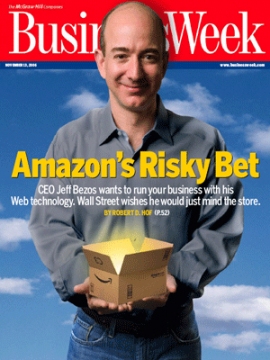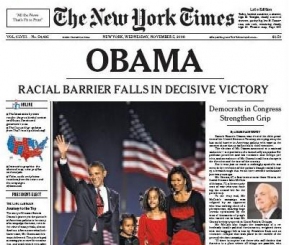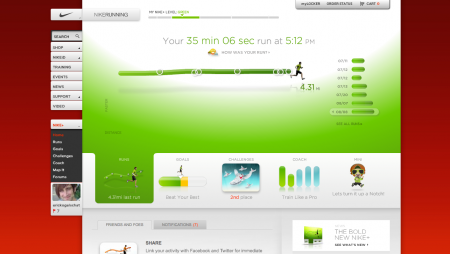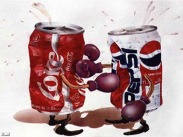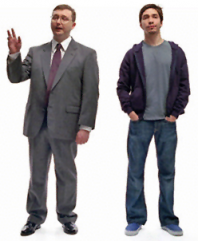The Future of Market Research
5 Innovations to Watch
The great David Ogilvy once said, “I notice increasing reluctance on the part of marketing executives to use judgment; they are coming to rely too much on research, and they use it as a drunkard uses a lamp post for support, rather than for illumination.” Those words from the great David Ogilvy are as true today as they were then.
Market research professionals, firms and organizations from IBM to Forrester Research are projecting the next trend in market research to be “making the transformation from research to insight.” If you ask me, that’s what market research has always been. An effective market researcher should be able to plan, conduct, analyze, and report actionable market insights and solutions to clients.
If you can’t do that, you’re probably just sharing stats that you found on eMarketer. I’m not discrediting eMarketer, which is an excellent research provider, but I see many advertising and marketing professionals searching for and relying too much on the latest stat or trend instead of taking that data point and translating it to something of value. Does that trend even make sense for your client’s unique situation? Or are you simply trying to impress them? This is not a problem with the research provider, but the researcher himself.
Instead of projecting the next trend in market research to be “making the transformation from research to insight,” which should already be innately infused into the mantra of the market researcher, I project the future of market research to be the convergence, or mash-up, of emerging technologies and lateral creative thinking across industries with the discipline of market research.
We are all living in a perpetual state of beta. We all have the ability at any time, to analyze our past and present to optimize for the future. And for market researchers, now is the perfect time to seize the opportunity to innovate the industry in ways George Gallup could have never imagined. So borrow from other competitors, borrow from other industries, borrow from culture – use lateral creative thinking to expand your potential and create new methodologies to reveal new insights and solutions. Below are five examples of this approach, which will continue to grow, especially in 2012.
Mash-up: Neuromarketing
Lateral Thinking: The Convergence of Neuroscience & Market Research
What is it? How does it work?
- It has been a goal of market research professionals to better understand motivations and behaviors for years. We are always asking ourselves why someone behaves the way they do. There are traditional quantitative and qualitative techniques that allow us to better understand this, but some insights are buried deep in the subconscious part of the brain that we can’t always reach. Neuromarketing takes the discipline of neuroscience and applies it to marketing, allowing us to gain insights into the subconscious.
- Neuromarketing can be utilized via several different methodologies, each with a unique purpose:
- Functional magnetic resonance imaging (fMRI): To measure increased brain activity by detecting changes in blood flow.
- Steady state topography (SST): To measure increased brain activity by detecting brain electrical activity or neural processing speed. This is much more cost effective than fMRIs.
- Electromyography (EMG): To measure electrical activity produced by skeletal muscles.
- Facial Electromyography (EMG): To measure electrical activity produced by facial muscles.
- Biometrics: To measure human body characteristics such as fingerprints, eyes, hands, vocal and facial patterns, and even DNA.
- Galvanic skin response: To measure the electrical conductance or moisture levels of skin.
- Eye Tracking: To monitor and track eye movement in order to denote the levels of attention on specific areas.
- Who has used this?
- How can I learn more?
- Watch the TV program: PBS “Frontline”: The Persuaders Read the book: “The Hidden Persuaders”
- Read the book: “Buyology”
- Read the blog: Neuromarketing
- Read the blog post: The Convergence of Cognitive Neuroscience and Marketing
Lateral Thinking: The Convergence of Gaming & Market Research
Mash-up: Research Through Gaming (RTG)
What is it?
- Creating market research environments infused with the dynamics and mechanics of gaming in order to monitor and analyze behavior.
- RTG can be used on almost any analog or digital platform, whether it’s event marketing, Facebook or a mobile application. The goal is to create an environment with goals or achievements that the participant can earn, which encourages participation; and a metrics tracking suite that records all behavior, so that data can be analyzed following the study.
- Who has used this?
- How can I learn more?
- Follow the conversation on Twitter: #gamification #NewMR
- Read the blog post: The Future of Research Through Gaming
Lateral Thinking: The Convergence of Mobile Technology & Market Research
Mash-up: Mobile Technographic Research
What is it? How does it work?
- As the adoption of mobile devices such as smartphones and tablets continues to increase and the technology that supports these devices is enhanced, market research professions will have the ability to go native, conduct research and report results in real-time. This can include smartphone and tablet surveys, texting surveys or mobile apps.
- Who has used this?
- At a previous agency, I conducted primary research for RIDGID, using multi-touch surveys on iPads.
- How can I learn more?
- Research survey apps for tablets and smartphones in the Apple App Store, Android Market, BlackBerry App World, etc.
- Research gadgets such as microphones and camera lenses to enhance your mobile device as a research tool.
Lateral Thinking: The Convergence of Social Media & Market Research
Mash-up: Social Intelligence or Digital Anthropology
What is it? How does it work?
- Every day we share our opinions, preferences and lives with people online via Facebook, Twitter and beyond. All of our passive data, or tweets, photos and videos, are archived online by the social networks to which we belong. Social media data is insanely valuable to marketers because it does not represent our intended behavior, but our overt behavior. Social media isn’t just word-of-mouth, but passive consumer behavior and consumption translated to consumer intelligence. However, before brands can act on this, they need access to this data in order to translate it into information that can improve their marketing strategies. Therefore, brands must enact listening platforms (e.g. community managers) and data mining tools (e.g. Radian6) to gain access to this data and harness the power of social media. Social intelligence can be used to develop new products, messaging platforms or define audience personas.
- Who has used this?
- Intel
- At a previous agency, I conducted primary research for Cleveland Clinic, using Radian6.
- How can I learn more?
- Read the white paper: Forrester “Defining Social Intelligence”
- Read the white paper: Radian6 “Defining and Measuring Intelligence”
Lateral Thinking: The Convergence of Crowdsourcing & Market Research
Mash-up: Online Panels
What is it? How does it work?
- People love to hate focus groups. I think every market research professional can agree that there are positives and negatives to conducting focus groups. But the ideal environment for a focus group fosters co: (community, collaboration, crowdsourcing and co-creation). When you take that ideal concept and apply it to a closed digital environment with incentives for passionate stewards of the brand, you will be inspired with consumer insights focused on innovation for your brand.
- Who has used this?
- How can I learn more?
- Watch this video: Napkin Labs “Introduction”
Lastly, while it is not one of the innovations listed above, I believe reporting should be a priority for all market research professionals. We must always understand how to translate data to information and reveal insights that are clear, concise and simple. We've been spending the past few years, creating and refining our infographics, data visualization applications and websites to better illustrate our strategic insights. These visual representations of our insights infuse energy into our research, bringing our insights to life in a compelling manner. While the future of market research is truly dependent on mashing-up emerging technologies and market research, it’s up to the individual to harness the potential and infuse strategy and creativity into the process.
The Great Race to Brand the Clouds
The benefits of technology and more specifically the internet, seem to be endless: information and data accessibility, entertainment, commerce, ease of communication, etc. For me, technology is attractive because it makes our lives easier to navigate. The innovation of cloud computing has made this even more apparent. The idea of syncing all of your files (photos, music, documents, etc.) and having accessibility wherever you are, is absolutely amazing. When I was in college at Michigan State University, each student received 100MB of AFS space. AFS is the acronym for "Andrew File System," it is the central MSU network file storage system, which was originally developed at Carnegie Mellon University in 1984. The idea was to provide a campus-wide file system for home directories. With this, I built my first website. I also used this space to save files for all of my different courses. I could then visit the main library or friends' dorm rooms and still have access to all my files. I thought this was great, but I used it mainly as a FTP service, which wasn't very convenient. However, cloud computing is now available to everyone and sometimes completely free.
Many people don't understand what cloud computing is, although many people use it everyday. Whether you save emails from friends or family in your Gmail or Hotmail account, post photos to Flickr or videos to YouTube; you are saving your files on a network other than your personal computer - this is the cloud. But the cloud is much more intelligent than what I just described. These examples describe hosting solutions for you to save content, but the cloud also provides real-time access to save, edit and share documents, spreadsheets, presentations, music and movies. Many companies like IBM, Microsoft, Google, Amazon and Apple offer cloud computing solutions.
The cloud provides many opportunities for brands to create innovative marketing solutions such as Apple MobileMe, Nike+ or Google Maps. But what company will win? What brand will win the great race to brand the clouds?
What is cloud computing?
Cloud computing, also known as utility computing or hardware as a service (HaaS), is the instant access to dynamic and scalable resources to operate software and applications over the internet. The cloud is defined by six elements:
- Infrastructure (Infrastructure as a Service - IaaS): Is a service providing the seamless architecture and resources (e.g. servers, CPU, memory, etc.) for instant, dynamic and scalable computing power (e.g. Grid computing, virtualization, etc.)
- Storage: Is a service simply allowing you to store your content (e.g. Rackspace)
- Platform (Platform as a Service - PaaS): Is the service that provides hardware and computing software allowing you to remotely access and operate your cloud server to develop, test, deploy, host and maintain applications (e.g. Microsoft Azure Services Platform, Amazon Web Services, Apple MobileMe, Microsoft Live Mesh,etc.)
- Applications: Are the tools that provide functionality to perform various computing tasks, such as uploading creating, editing and sharing documents, spreadsheets or presentations (e.g. Google Docs: Document, Spreadsheet, Presentation, Form)
- Software/Service (Software as a Service - SaaS): Is the service that delivers and is utilized in real-time over the internet (e.g. Google Maps, OpenID, PayPal, etc.)
- Client: Is the computer hardware/software dependent on cloud computing in order to operate (e.g. Mozilla Firefox, Palm Pre webOS, Google G1 Android, Apple iPhone OS)
The idea behind the cloud seems so natural, why not have access to everything you want, whenever you want? Moreover, why not use another network other than your own? Especially if it's cost efficient. In a Wired article titled "Cloud Computing. Available at Amazon.com Today," Spencer Reiss and the CEO of Amazon, Jeff Bezos, discuss the cloud:
"Utility computing is Web 2.0's version of rocket fuel. 'You don't generate your own electricity,' Bezos says. 'Why generate your own computing?' The forces driving online apps — internet bandwidth and reliability — also mean that, in terms of data per dollar, servers in your closet or co-location facility can't compete with industrial-scale bits piped in from hundreds, even thousands, of miles away."
The Cloud: Strengths
- Accessibility: Cloud-based services allow you to retrieve data and information wherever you are: home, work or play - as long as you have an internet connection
- Captivating: These services become a part of your daily life because they provide utility and convenience
- Convenience: The ability to access files, music and photos no matter where you are
- Content Generation: Users are able to create content wherever they are and in some cases in places they normally wouldn't
- Inexpensive: The cost to utilize the cloud varies. The current cost structure is either free, based on a monthly subscription or by frequency of use
- Instant Computing Power: Every computer is limited to certain level of power, however with the cloud you can use someone else's computing power instantly without purchasing another hard drive
- Scalability: As you require additional space to conduct more work, the cloud allows you to readily increase resources
- Synchronization: My personal favorite benefit of the cloud, the ability to sync online and files on other computers
- Usefulness: This is the true strength that every brand should utilize. The cloud can support many different services that provide utility
The Cloud: Weaknesses
- Profit Margins: In a Wired article titled "Microsoft’s Ray Ozzie Sees Lower Margins From Cloud Computing," Reuters explains that "Microsoft Corp’s chief software architect says the profit margins on providing online services — broadly known as cloud computing — would likely yield a lower profit margin than the company’s existing software business." This obviously isn't a disadvantage for consumers, but for companies, the margin from software is greater than cloud computing
- Reliability: The reliability of cloud computing can be an issue. If your internet connection goes down, you won't have access to your most important files (e.g. Google doc or map)
- Speed: The efficiency of your infrastructure and internet connection will affect performance; and depending on the platform you are using, this may help or hinder performance
- Ubiquity: While the cloud-based service you use for your personal files are technically available all the time, anywhere; you may not always have access due to internet accessibility or connection speed
The Cloud and Branding
Understanding the advantages and disadvantages of the cloud allows brands to utilize the inherent drama of cloud technology to create innovative marketing solutions. In an ADWEEK article titled "Investing in the Cloud" Bob Greenberg, the chairman, CEO of R/GA, explains that "there is absolutely no reason why brands can’t get into this game. At its core, cloud-based marketing is powered by a simple idea: be useful to your customers and they in turn will be loyal to your brand. The cloud is a massive engine of technological utility, with myriad ways to be useful to customers." More specifically, the cloud allows brands to create marketing services that:
- Provide utility. Brands have the opportunity to augment current services or create new services that are useful in the daily lives of their customers, which could enhance their brand image and loyalty
- Create an engaging experience. These interactive services captivate customers
- Encourage content generation. As consumers continue to use these services, they are directly fueling the cloud-based service with new content as it is integrated into their daily lives
- Utilize a new medium. As Greenberg explains, "...by building cloud-based services, brands create instances of “owned” media. These media channels have reach, frequency and 100 percent relevance with the intended audience."
- Decrease media budget. As Greenberg explains, "...the old investment model for advertising was based on roughly a 20/80 split: spend 20 percent of the budget conceiving and producing the idea, and 80 percent on media delivering the message. The cloud-based service model inverses this split: spend the lion’s share developing the technology and just a small amount on a bit of paid media to spark awareness. Beyond that, “earned” media takes over and consumers and PR channels spread awareness virally to drive further adoption."
- Utilize a new financial model. Brands must continue to support advertising campaigns by investing in media otherwise results will be nonexistent. However, production for cloud-based services is inexpensive and continues to reach consumers frequently as they become dependent on these useful services to help navigate their lives. Over time, the cloud will decrease marketing costs
Below are case studies of brands that understand and embrace the cloud as part of their offerings as well as a few brands that just don't understand the cloud.
Amazon Web Services (AWS)
One of the pioneers of cloud computing is Amazon. Cloud computing became a solution for Amazon when they were on a journey to discover something very different. In 1999, Amazon wanted to open its storefronts up to third-party selling, all in response to eBay. At the time, it seemed odd that Amazon would open the doors to third-parties, but in Jeff Bezos' words, "If you're trying to have not just every book but every out-of-print book, every indie-band CD, and every vinyl record, there's no way you're going to do it on your own. You have to open up." The result was Amazon auctions, which later became the current Amazon Marketplace. But to make this idea a reality, they had to solve technical problems with speed, reliability and scalability to support these third-party storefronts on their databases and servers. This resulted in a new architecture with unexpected opportunities. As stated by Spencer Reiss in a Wired article titled "Cloud Computing. Available at Amazon.com Today," Amazon's next new business was "opening not just the store in the sky, but the very silicon and software that keeps it aloft." Reiss further explains that:
"AWS capitalizes on Amazon's combination of computational skills and operational savvy. It piggybacks on a multibillion-dollar IT infrastructure. And it pulls in a whole new category of customers looking for rock-solid scalable computing on demand — blue-chip startups like Zillow and PowerSet, kids in garages building the next Google, even adventurous corporate IT jocks looking to offload some of the drudgery."
AWS is an example of a cloud computing platform (platform as a service - PaaS) and leverages all of the cloud's advantages. What's interesting about AWS is that it wasn't created as a product, but as a byproduct from another idea. Regardless, Amazon successfully utilized the cloud to develop a cloud service that companies and individuals will utilize. Further, as Amazon continues to refine its service, the overall brand image will be augmented and hopefully brand loyalty will follow in other Amazon services. I think it will.
New York Times
Similar to how Google Books allows users to search full text from millions of books, the New York Times as digitized over 150 years worth of newspapers into searchable PDFs all of which are hosted on Amazon's cloud servers. This is a great example of a brand facing pressure to remain relevant as emerging media changes the landscape. Again, providing useful information in a convenient manner and planning for future growth. FYI: Twitter and Justin.tv also utilize AWS to host data and information.
Google Docs
If you are not familiar with Google Docs, the video above by Common Craft provides a great explanation, in plain English. Google Docs provides every benefit that the cloud can offer, everything from convenience to scalability to synchronization. And actually, scalability will be even more evident with the future release of the GDrive, which will allow consumers to purchase additional space for their Gmail, Docs or Picasa photos. Search was the main service that Google provided, however they saw the opportunity in the clouds and beat Microsoft to claim the cloud-based word processing and spreadsheet market. While Microsoft's cloud-based Microsoft Office Live Workspace is available, it was Google that really took advantage of the cloud. Of course hindsight is always 20/20, but the inherent problem with word processing and spreadsheet files was that you didn't have one central version - the cloud made this possible. Google saw this opportunity and seized the moment.
Nike+
Nike+ is a perfect example of what brands can accomplish by utilizing the cloud to augment or create products/services that become a part of people's lives and change it in a positive way. For those runners that have a Nike+iPod, upon completing a run, they can sync their iPods and upload their data to the Nike+ website. Here is where the beauty of the cloud works. Once runners visit the site, they can review a dashboard of recent runs, set goals and create challenges or training programs. And even sign-up for online and offline events, such as The Nike+ Human Race. All of this information is saved in the clouds and users have the ability to access it via the Nike+ application (i.e. website). The Nike+ sensor and chip may technically be the product Nike sells, however it is the service and experience they provide that makes this an amazing brand experience. On a personal note, I have been using Nike+ for almost three years now and absolutely love it. Only a few months ago, shortly after Wired featured Nike+ on the cover for unleashing the power of personal metrics, Nike with the help of R/GA completely redesigned the Nike+ website. It's beautiful. Usability has been enhanced. And social media tools have been integrated to help extend awareness of the product/service to a larger audience.
Fiat eco:Drive
Together, AKQA and Fiat created a Nike+ for Fiat vehicles called Fiat eco:Drive. Utilizing a USB drive, this technology tracks your driving technique and the online application than analyzes your driving style to help you improve how efficient you drive in order to use less fuel, which will reduce your CO2 emissions and save you money. Similar to Nike+, users can share their information with a community, called Ecoville. Again, it's this cloud-based application that allows users to reference data and better understand how they can change their driving style to help the environment. Users do not save their information on their personal computers, but in the clouds. Very impressive.
Kodak Gallery
Similar to Flickr, Kodak provided a free online photo gallery service where users could save, print and share their photos. This business model was sustained on the hope that customers would at some point, opt-in for premium services to offset the free users, also known as the "freeium" model. However, Kodak Gallery decided to change their business model. In an AdAge article titled "This Cloud (Computing) Has No Silver Lining," Matthew Knell explains that Kodak began requiring "users to make minimum purchases in order to subsidize the use of its websites and kill its "freemium" model. The new plans range from $4.99 to $19.99 per month. And if you don't pay the fee or provide a minimum purchase by a given date? Your photos will be deleted." This is a problem many online newspapers are experiencing right now. As newspapers continue to lose subscribers, many online versions of the newspapers (e.g. Wall Street Journal) are asking users to subscribe for premium online services. But even the Wall Street Journal still provides some free online services. Kodak essentially implemented a bait and switch tactic to lure customers in and quickly changed their business model. By changing their business model, Kodak ruined their brand image and may have ended the loyalty that many of the users had. While the cloud service that Kodak initially provided fulfilled the users' expectations of accessibility, convenience and price - by changing their service, Kodak removed what may have been the most important benefit to its customers. Before brands develop cloud services, they must plan for the future. If you foresee that you may have to charge your users in the future, do so at the onset and provide a service that is worth the financial commitment.
Evernote
And now for the number one reason I love the cloud, data synchronization. There are many brands out there right now that are developing apps or services around this benefit: Apple MobileMe, Microsoft Live Mesh and Evernote. This technology allows users to sync files, folders and other data across multiple devises. Evernote's tag is "Remember Everything" and this is completely true. Users are able to create content, sync it on their computer, mobile phone or online and then access it anywhere. I downloaded the Evernote app for my Palm Pre, but I have to wait until I purchase Leopard for my Mac.
The Great Race to Brand the Clouds
The cloud inherently provides many opportunities for brands to create innovative marketing solutions such as those listed above. To answer the question I posed earlier, what company will win? What brand will win the great race to brand the clouds? The answer is every brand that embraces the cloud and creates new services that are engaging and encourage content generation, and utilize a new medium that is cost effective. Lastly, as Bob Greenberg explains in an ADWEEK article titled "Investing in the Cloud" the cloud "is about the democratization of technology - and democracy is a good thing. Make sure your brand participates." However, while it is a democracy, I believe a few brands make it a monarchy:
- Amazon branded the clouds as a platform (Platform as a Service - PaaS). Interesting note, Amazon was the first company to sell cloud computing as a service
- Google branded the clouds for utility applications. While Microsoft does have their full Office suite available online, Google made a bigger impact
- Nike+ branded the clouds for entertainment applications. As of yet, we have not seen anything as integrated into the lives of its users
Open Source: The Model Is About Branding
The traditional business model for companies is to create a product and/or provide a service to customers in order to receive payment and hopefully exceed operational costs to generate a profit. However, what happens when you are not creating a product or service, but instead ideas? How do you make a profit? How can you differentiate yourself from the competition when your product is perceived as a commodity? This is a common dilemma for companies that engage in Open Source design, development or distribution. As defined by the Open Source Initiative, open source is "a development method for software that harnesses the power of distributed peer review and transparency of process. The promise of open source is better quality, higher reliability, more flexibility, lower cost, and an end to predatory vendor lock-in." The benefits for open source are compelling and the idea of creating a community of the brightest minds to create something new is inspiring. This idea of sharing your creative wealth to accomplish great things is something the Creative Commons embraces.
The inherent drama of open source is that it's the collaboration of peers orchestrated in transparent manner, so competitors can easily observe all of your ideas and replicate. Most economists would argue that open source is not a sustainable business model; there are no tangible "widgets" or returns.
There are also skeptics within in the open source community that claim the open source business model is broken because value is in the collaboration, not in open source itself. However, the true return comes in an intangible form - your brand.
Case Study: Open Source Hardware
In a Wired article titled "Build It. Share It. Profit. Can Open Source Hardware Work?" Clive Thompson writes about a computer hardware company called Arduino. All of their schematics, design files and software for the Arduino board are open source, so anyone can download them to use or modify and manufacture their own boards - and even sell if they want. Arduino's open source hardware has been used in everything from DIY MP3 players to mobile phone charges to humidity/temperature monitors for art museums. If Arduino utilizes an open source business model in which they essentially give intellectual property away, how do they make a profit? This is where I find this case study very interesting; it's all about the brand. As Thompson explains, there are two economic models for open source:
- Do not sell your product (i.e. hardware or software), but instead sell your expertise as the inventor
- Sell your product, but try to keep ahead of the competition
The Arduino team doesn't receive a profit when they actually develop boards; it's usually rolled back into the next production cycle. However, they do receive a "profit" when they act as consultants to companies using their open source hardware. Since the hardware is open source, the open source community collaborates to improve the hardware, so they essentially have free labor. And because Arduino is the creator of this hardware, they are at the epicenter of the community and learn about advancements before anyone, so they are the first one to the fight every time.
To analyze Arduino from a business model perspective, expertise is the service provided to customers. Further, operational costs are minimal, so a profitable return is likely. However, while their competitive advantages are notable, the differentiating factor is their brand - a value proposition providing dependability as a benefit to customers. This is due to their success and expertise as pioneers and leaders in the open source hardware community.
Case Study: Open Source Desktop Operating Systems
Open source technology is most notable in desktop and mobile operating systems, specifically Linux and Google Android respectively. Linux is a free Unix-type operating system originally created by Linus Torvalds with the assistance of the open source community. Developed under the GNU General Public License, the source code for Linux is freely available to everyone. Around the world, Linux has great brand recognition with developers, however little to none with consumers. This is likely due to the fact that Linux is used primarily in servers and computer hardware, which is not typically consumer facing. Also, historically the use of Linux in desktop and laptop computers has been quite low. Further, due to the lack of a strategic marketing plan, consumers are not aware of the Linux brand. However, due to the recent Ubuntu distribution and emergence and popularity of netbooks, the market share of Linux is growing. Currently, the market share for desktop operating systems is as follows:
- Microsoft Windows: 87.90%
- MAC: 9.73%
- Linux: 1.02%
- Apple iPhone: 0.55%
- Apple iPod Touch: 0.15%
- Java ME: 0.07%
- Other: 0.32%
Ubuntu is leveraging the Linux brand and open source technology to create its own product (operating system) and brand (Ubuntu). This is somewhat similar to the co-branding efforts of Intel with many PC brands, but without the licensing fees. While Linux is gaining brand awareness due to the Ubuntu distribution, it is not actively promoting its own brand. Linux is taking an open source approach to branding itself - allowing other brands to help define its brand identity and image. I'm curious to see how this will affect the brand in the future. I would hypothesize that it will only augment the brand's image and further the popularity of open source. Currently, Linux is not following either of the two economic models presented earlier, however I wouldn't be surprised to see Linux start selling its expertise more as its market share continues to grow.
Case Study: Open Source Mobile Operating Systems
When Google's Android mobile operating system was released, specifically in the T-Mobile G1, many thought that this would be a strong competitive force against the Apple iPhone. However, this is an example of an open source initiative that resulted in negative outcomes and poor branding. According to a ReadWriteWeb article titled "Android Vulnerability So Dangerous, Owners Warned Not to Use Phone's Web Browser," written by Sarah Perez, in February 2009 a security researcher presented a new vulnerability in Google's Android mobile OS that allowed hackers to remotely take control of the phone's web browser and related processes. Hackers could gain access to saved credentials in the browser and browser history. It was recommended that Android users "avoid using the browser until a patch is released. If this is not possible, only visit trusted sites and only over the T-Mobile network (avoid WiFi). This issue with security was the main reason I took the G1 and all smartphones with the Android OS off my consideration list. This infiltration damaged the Google Android brand. This can be a problem with any open source technology because many people have access to the source code. However, this really isn't any different than a hacker can reverse engineering any product to bypass security - it's just that open source makes it more convenient. Either way, security systems must be built in to restrict vulnerability. Then Google experienced a problem with branding. According to a TechCrunch article titled "Should Google Be Paranoid About Losing The Android Name?" written by MG Siegler, a person applied for and was granted a trademark to the Android name back in 2002. Google tried to trademark the name in 2007 after the Android campaign, however it was rejected. Google tried again but was repeatedly denied and its trademark application was suspended. So any equity that Google may have built with the Android brand may be gone because they will need to completely rebrand their open source mobile operating system. Which may work to their advantage, so that they can redefine the brand and move on from all the security problems. Hopefully, Google Android will redeem the brand with the new Samsung Android smartphone out later this year and with the enhancements to the G1.
Case Study: Open Source Web Browsers
Mozilla was the first open source initiative that I ever heard about. The Mozilla Foundation began in 1998 to "create world-class open source software" and they did just that. They supported the open source community by embracing the pillars of open source: Openness, Innovation and Participation. Then in 2002, Mozilla released their first web browser, Mozilla 1.1. However, at this time Microsoft Internet Explorer had over 90% of the market share for internet browsers. Mozilla had their work cut out for them. However, in 2003, Mozilla created Firefox a world-class tool to experience the internet and began to experience tremendous growth.
The tipping point, however, was their grassroots approach to branding. Similar to the manner in which Firefox was created, Mozilla turned the marketing and advertising efforts over to its supporters by launching a campaign called "Spread Firefox." This website became the community hall for the discussion of marketing and advertising strategies. Among many things, supporters were encouraged to place "Get Firefox" buttons on their websites and blogs to help promote Firefox. Each participant would be rewarded referrer points as an incentive to be included among the top 250 referrers, a list that would be featured on the Spread Firefox website. Mozilla's community marketing guide includes categories such as:
- Organizing and Attending Events
- Public Speaking
- Blogging, Tagging and Social Networking
- Advertising Mozilla
- Making T-Shirts and Other Items
- Guerrilla Marketing Activities
- Collecting Testimonials
- Distributing Software
- Promoting the Mozilla Mission
- Collecting Press Clippings
- Speaking to the Press
- Requesting Sponsorship for a Project
- Reporting Disreputable Behavior
The last category is very interesting, not only did Mozilla ask supports to help promote the product, but also police online activity and warn Mozilla of harmful behavior to their reputation. Even while Mozilla embraced the pillars of open source (openness, innovation and participation), they managed to control the message as well. From a branding perspective, this is something Mozilla has been relentless at. The name "Mozilla Firefox" is a registered trademark and along with the official Firefox logo, it may only be used when specific terms and conditions are followed. While the code for the Firefox browser is open source, there are usage restrictions placed on the code. If derivative works from the code are created, the browser must be rebranded - the new browser cannot leverage the brand name or logo. The strategic rationale is that Mozilla wants to guarantee a consistent user experience for anyone using the Mozilla Firefox web browser. This is something every brand hopes for. There has been some controversy over this, however this is also the reason why Mozilla Firefox has been so successful. Currently, Firefox is the #2 web browser on the market, with market share just over 20%. Below is the current market share for web browsers:
- Microsoft Internet Explorer: 66.10%
- Mozilla Firefox: 22.48%
- Apple Safari: 8.21%
- Google Chrome: 1.42%
- Opera: 0.68%
- Other: 1.11%
This isn't bad for a non-profit organization, especially when its competition is Microsoft, Apple and Google. A true branding effort that produced results. Mozilla even holds a Guinness World Record for the most software downloaded in 24 hours. To analyze Mozilla from a non-profit business model perspective, they are fulfilling their mission statement: To make the internet better for everyone by embracing openness, innovation and opportunity.
Case Study: Open Source Politics
President Barack Obama's election campaign was seamless, engaging and effective. And he now continues this sound strategy during his presidency. At 12:01 p.m. on Tuesday, January 20th, just one minute after Barack Obama became the 44th President of the United States, www.whitehouse.gov was rebranded and the first entry to the White House blog was created: "Change has come to WhiteHouse.gov"
Macon Phillips, the Director of New Media for the White House, explained that like our new government, WhiteHouse.gov and the rest of the Administration's online programs will put citizens first. And that the initial new media efforts would center around three priorities:
- Communication
- Transparency
- Participation
It's interesting to note, that these three priorities reflect the philosophical pillars of open source and Creative Commons. Further, at the time I am writing these words, it's exactly 100 days after President Obama was sworn in. So it seems to be the perfect time to evaluate these priorities.
- Communication: Constant communication via an array of channels - the Administration has reached out to citizens online, TV, press, etc.
- Transparency: The activity on WhiteHouse.gov alone showcases the level of transparency. However, an interesting example of transparency is the creation of Recovery.gov, which was built on the Drupal platform - an open source platform with a reputation of innovation, stability and malleability. Further, the use of open source is significant because security is an obvious concern for the government. Lastly, due to the community surrounding this open source platform, as developers improve functionality, everyone will benefit.
- Participation: President Obama engaged with America and asked them to participate in their government with an initiative called "Open For Questions." Obama asked people to participate in the community-moderated online town hall by submitting questions about the economy utilizing similar voting functionality as Digg.com
Obama's brand was clearly defined before he became President, however on the day he entered the oval office not only did he rebrand WhiteHouse.gov, but he also rebranded what it meant to be President of United States of America. President Obama set the precedent for all future presidents: A transparent process that engages American citizens. And once you start the conversation, you cannot leave it. Future Presidents will be expected to work in a similar manner. Lastly, as the Administration integrates more technology (i.e. open source development) the methods and levels of engagement will advance and deepen respectively. Citizens will take an active role in government and expect that their involvement will make a difference. Similar to President Franklin D. Roosevelt and his fireside chats, Obama changed the way the President communicates with Americans. Whether you support Obama or not, the brand Obama has established thus far, is the differentiating factor between him and other presidents - Optimisim, Change, Transperancy and Community. It's also essential that you live up to your brand promises, otherwise your brand image will deteriorate. So, there is still a lot of work to be done. My only issue with the presidency campaign thus far are the multiple number of websites: WhiteHouse.gov, Recovery.gov, HealthCare.gov (previously HealthReform.gov), FinancialStability.gov, etc. Multiple destinations for the User can become confusing.
The Convergence of Cognitive Neuroscience and Marketing
When I moved to Boston over a year ago to work for Modernista! on the Cadillac account, I quickly put an ad on Craigslist to join a band. Throughout high school and college, I had been in a band, but took some time off to focus on my masters program at Michigan State University. To say the least, I was anxious to get back into music. Soon after joining my new band, I found out that all of my band members were neuroscientists at well-renowned universities - Boston College, Harvard and MIT. Frequently while waiting for shows to begin, we would sit together and debate our set list for the evening. The discussion would usually focus on music, but every so often neuroscience would become the topic of discussion. It was interesting to hear their thoughts and ideas on neuroscience, however I couldn't help but think how neuroscience could be applied to advertising.
Brand Image and Loyalty
A few years ago, I read an article in the New York Times that explained the convergence of cognitive neuroscience and marketing. Since then I have been very interested in how advertising and marketing affects culture and more specifically the brain. The NYTimes article that inspired my interest in neuromarketing was "There's a Sucker Born in Every Medial Prefrontal Cortex" by Clive Thompson. It announced the rise of neuroscientists and researchers applying their expertise to marketing. Instead of using the normal marketing research technique of surveys or focus groups to gain insight, they used MRI (magnetic resonance imaging) to analyze brain activity when exposed to different stimuli. The article predicted that marketers would soon have departments dedicated to neurology in order to reveal deeper insight into consumer behavior. Further, brain activity in specific areas of the brain could explain brand engagement. Historically, it was thought that the ventral putamen (the region of the brain that processes feelings of reward) could explain brand preference. However, more precisely, it is the medial prefrontal cortex that explains brand engagement. The medial prefrontal cortex would activate when individuals felt a connection with the brand or if it reflected their self-image. The study featured was the famous Pepsi/Coke Challenge.
Growing up in the '80s, I remember seeing many commercials about the famous Pepsi/Coke Challenge - an illustrative example of product comparison rooted in research. But what was interesting about this experiment was not necessarily the results, but the process. The initial results of the challenge were clear, Pepsi was the winner. Unaided brand preference was stronger for Pepsi than Coke. In fact, brain activity in the ventral putamen for Pepsi drinkers was "five times as active when drinking Pepsi than that of Coke fans when drinking Coke." However, consumers are exposed to an array of brand communications and true rational preference is often affected by one's emotions. To take this into consideration, the experiment was repeated. This time, the participants were informed which samples were Coke. The results were astonishing, almost all of the participants said that they preferred Coke.
"The brain activity of the subjects was now different. There was also activity in the medial prefrontal cortex, an area of the brain that scientists say governs high-level cognitive powers. Apparently, the subjects were meditating in a more sophisticated way on the taste of Coke, allowing memories and other impressions of the drink - in a word, its brand - to shape their preference."
Obviously, for advertising professionals this is very exciting - it provides evidence on the true impact of branding. Further, it's exciting to imagine the future of brand planning in this regard.
Brand Recognition
We are exposed to over 2 million advertising messages during our lifetime. This translates to 8 hours a day, 7 days a week, for 6 years. Consumers leverage selective perception to acknowledge the messages they find meaningful and important. When launching a new product, how do you ensure that your brand is recognized? According to neuroscientists, marketers need to capture consumers' attention at a subconscious level in order for their message to resonate with the consumer. This requires emotional branding that can affect the consumers rational preferences.
A brand that has truly captivated their target audience is Tiffany. That famous little blue box. Just the sight of the white ribbon wrapped around that blue box provokes so many emotions. The Tiffany logo is on the box, but not visible when the ribbon is on the box. The idea that the little blue box provokes so many emotions is best explained in an AdAge article titled "You May Love the Logo, but It's a Dying Breed" by Martin Lindstrom and a segment from the NPR program Talk of the Nation titled "The 'Buyology' Behind The Way We Shop" featuring Lindstrom as well.
In both the article and NPR segment, Lindstrom references Marlboro. Whether you are a smoker or not, you probably recognize the famous Marlboro man. This character created by the advertising agency, Leo Burnett in the '50s has become an iconic image. The same has become true for the brand's sponsorship of a red Ferrari in Europe's Formula One racing. Lindstrom was curious if "cigarette cravings could be triggered by images, such as the red Ferrari, that are tied to a brand of cigarette, but not explicitly linked to smoking?" Lindstrom found the answer to this question by using MRI and fMRI (functional magnetic resonance imaging). The brain scans revealed increased brain activity when exposed to cigarette packs as well as the Western imagery in a small region of the brain called the nucleus accumbens, which controls pleasures and addictions. However, the unbranded images (e.g. cowboy) activated more cravings among smokers than the branded images (e.g. cigarette packs). The same is true for the Coca-Cola bottle. Just the shape of the bottle may activate the nucleus accumbens in some individuals.
Essentially, through branding, these images have come to embody the essence of the brand. The little blue box, Coke bottle and cowboy, activate areas of the brain at a subconscious level, resulting in strong emotions and ultimately a desired behavioral reaction. Critics may call this subliminal advertising, however when a brand logo or symbol become recognizable at an iconic level, it may reach the consumer at an subconscious level, however the intention is not destructive, but a natural development of human psychology.
Brand Engagement
Apple's PC vs. Mac campaign has been very successful, not only at creating a strong point of differentiation between themselves and the competition, but also establishing a strong brand image by engaging the consumer. According to an AdAge article titled "Is the Ad a Success? The Brain Waves Tell All" by Stuart Elliott, after the winners of Cannes and the Effie Awards were announced in 2007, a neuromarketing firm measured the brain activity of participants when viewing the winning commercials. They measured biometrics of the brain waves, galvanic skin response, eye movements and pulse rates. The results found brand engagement as the differentiating factor.
"Fifteen of the 19 Cannes and Effie winners engaged consumers faster than average spots. Typically, a spot engages with viewers in 5 to 7 seconds. The Cannes and Effie ads engaged, whether emotionally or cognitively, in 1.5 seconds.”
This is very interesting considering that both awards recognize excellence in advertising on different attributes: Cannes recognizes creativity, while Effie recognizes effectiveness. Essentially, this tests emotional and cognitive advertising in the same manner and the result is that both methods are effective. But more importantly, it is brand engagement that defines success. For example, the Apple PC vs. Mac "Get a Mac" campaign won the Grand Effie at the 39th annual Effie Awards in 2007 and the Volkswagen "Safe Happens" campaign won the Gold Lion at Cannes in 2007. It's the cognitive reaction to the emotional moment that grabs the consumer.
The success of Apple's iPod branding is pervasive. It's impossible to walk downtown in any city and not see those white earbuds. However, from a holistic perspective, it's interesting to see how the Apple brand stimulates brain activity. In a segment from the NPR program "Weekend Edition," titled "Study: Apple Logo Stimulates the Brain," Duke researcher Gavan Fitzsimons, investigates what responses participants have to the Apple logo. In Fitzsimons' study, participants were exposed to an Apple or IBM logo prior to completing a creativity test. The results showed that those exposed to the Apple logo scored 20-30% higher than those exposed to the IBM logo. Thus correlating creativity with Apple and competence, organization and professionalism with IBM. Therefore, consumers should surround themselves with brands that reflect their perceived or ideal self-image to help bring these attributes to fruition or even augment existing attributes. For brands, this means niche marketing and reaching those consumers that you want to embody your brand and opinion leaders that will help disseminate the brand image you desire.
Reach and Frequency
The question that has plagued media planners for years: What is the most effective method to communicate with consumers? This is of course dependent on the client and current market environment, however it often results in an integrated media plan and a balance of reach and frequency. However, what if you were able to determine the exact moment when it was best to communicate with your consumer? Or to communicate with your consumer at the exact frequency required to be the first brand in their consideration set? This question can be answered by applying a unique algorithm to each consumer. This is investigated in a Wired article titled "Want to Remember Everything You'll Ever Learn? Surrender to This Algorithm" by Gary Wolf. A man by the name of Piotr Wozniak, created a program called SuperMemo, which is designed around the notion that "there is an ideal moment to practice what you've learned" in order to have it ingrained in your memory.
"Practice too soon and you waste your time. Practice too late and you've forgotten the material and have to relearn it. The right time to practice is just at the moment you're about to forget. Unfortunately, this moment is different for every person and each bit of information. Imagine a pile of thousands of flash cards. Somewhere in this pile are the ones you should be practicing right now. Which are they?"
What if we were able to apply this concept to advertising? What if we communicated to each consumer exactly at the moment we needed to? After reading this article, I wanted to purchase SuperMemo immediately. I wanted a version integrated into my iGoogle so that it could be tailored to my lifestyle and the subjects I want to learn more about. This is when I realized the power of applications and widgets. If you created a widget for your brand with relevant information the consumer would want and applied this method, you could reach them at the exact moment when influence was needed. Of course this is almost impossible because this is the ultimate opt-in communication for consumers, but what if? The key is relevancy. Providing information the consumer truly desires and that in a convenient manner.
Advertising: Art or Science?
Will the convergence of neuroscience and marketing force our industry to become a science? And more importantly, should it? Is advertising an art or a science? My personal belief is that advertising is a balance of art and science. However, I tend to lean more toward the idea of emotional branding and engagement branding. This is best explained in Marc Gobé's book, Emotional Branding:
“The future of branding is listening carefully to people in order to be able to connect powerfully with them by bringing pleasurable, life-enhancing solutions to their world. In the future, traditional companies will not be able to rely on their brand history or dominance in classical distributions stems, they will have to focus on providing brands with a powerful emotional content."
Creating a unique connection with your consumer and fostering that relationship with relevant information and solutions should be the basis for your marketing communications. Then, with the help of art and science, you can augment the brand experience via consumer insight, strategic planning, creativity and continually optimizing the work.


